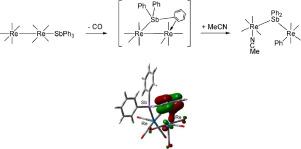Journal of Organometallic Chemistry ( IF 2.1 ) Pub Date : 2021-08-20 , DOI: 10.1016/j.jorganchem.2021.122034 Md. Abdullah Al Mamun 1 , Subas Rajbangshi 1 , Shishir Ghosh 1 , Michael G. Richmond 2 , Shariff E. Kabir 1

|
The reactions of the MeCN-substituted compounds [Re2(CO)9(NCMe)] and [H3Re3(CO)11(NCMe)] with SbPh3 are described. Treatment of [Re2(CO)9(NCMe)] with SbPh3 in refluxing benzene furnished [Re2(CO)9(SbPh3)] (1) in good yield. Complex 1 reacts with SbPh3 in the presence of Me3NO in acetonitrile to give [Re2(CO)8(σ-C6H5)(µ-SbPh2)(NCMe)] (2), which on further reaction with additional SbPh3 in refluxing benzene afforded the known complex [Re2(CO)8(σ-C6H5)(µ-SbPh2)(SbPh3)] (3). Heating 1 with SbPh3 at 110 °C yields 3, which on prolonged heating at 110 °C in the presence of SbPh3 furnished the known stibene-bridged compound [Re2(CO)7(µ-SbPh2)2(SbPh3)] (4). Complex 2 is a rare example of a dirhenium complex containing a sigma-bonded phenyl group and a labile acetonitrile ligand in the same molecule. The stibene-bridged dirhenium complexes (2−4) result from the cleavage of antimony-carbon and Re–Re bonds. Heating [H3Re3(CO)11(NCMe)] with SbPh3 in refluxing toluene afforded the new compounds [H3Re3(CO)11(SbPh3)] (5), [H2Re3(CO)11(µ-SbPh2)(SbPh3)] (6), and [HRe2(CO)6(µ-SbPh2)(SbPh3)2] (8) together with previously reported compound [HRe2(CO)7(µ-SbPh2)(SbPh3)] (7). Compound 5 is a simple monosubstituted product, while 6 contains a terminally coordinated SbPh3 ligand and a bridging SbPh2 group formed by Sb–Ph bond scission. Compound 8 results from cluster fragmentation and SbPh3 ligand activation by Sb–Ph bond cleavage. A series of separate thermolysis experiments have been performed in order to establish the relationship between the different products. Compounds 1, 2, 5, 6, and 8 have been structurally characterized by X-ray crystallography. The bonding in these new compounds has been investigated by electronic structure calculations.
中文翻译:

三苯基锑在 [Re2(CO)9(NCMe)] 和 [H3Re3(CO)11(NCMe)] 中的配体配位:反应性研究和 Sb-Ph 键断裂以产生新的含锑二铼和三铼配合物
描述了 MeCN 取代的化合物 [Re 2 (CO) 9 (NCMe)] 和 [H 3 Re 3 (CO) 11 (NCMe)] 与 SbPh 3的反应。在回流苯中用SbPh 3处理[Re 2 (CO) 9 (NCMe)],以良好的收率提供[Re 2 (CO) 9 (SbPh 3 )] (1)。在乙腈中存在 Me 3 NO的情况下,配合物 1 与 SbPh 3反应生成[Re 2 (CO) 8 (σ-C 6 H 5 )(μ-SbPh 2)(NCMe)] (2),在回流苯中与额外的 SbPh 3进一步反应得到已知的复合物 [Re 2 (CO) 8 (σ-C 6 H 5 )(µ-SbPh 2 )(SbPh 3 )] (3). 在 110 °C 下用 SbPh 3加热 1产生 3,在 SbPh 3存在下在 110 °C 下长时间加热提供已知的二苯桥化合物 [Re 2 (CO) 7 (µ-SbPh 2 ) 2 (SbPh 3 ))] (4). 配合物 2 是二铼配合物的一个罕见例子,在同一分子中含有一个 σ 键合的苯基和一个不稳定的乙腈配体。锑-碳和 Re-Re 键的裂解产生了锑桥连二铼配合物 (2-4)。在回流的甲苯中用 SbPh 3加热 [H 3 Re 3 (CO) 11 (NCMe)]得到新化合物 [H 3 Re 3 (CO) 11 (SbPh 3 )] (5), [H 2 Re 3 (CO) 11 (µ-SbPh 2 )(SbPh 3 )] (6) 和 [HRe 2 (CO) 6 (µ-SbPh 2)(SbPh 3 ) 2 ] (8) 连同先前报道的化合物 [HRe 2 (CO) 7 (μ-SbPh 2 )(SbPh 3 )] (7)。化合物 5 是一个简单的单取代产物,而 6 包含一个末端配位的 SbPh 3配体和一个由 Sb-Ph 键断裂形成的桥连 SbPh 2基团。化合物 8 来自簇断裂和 SbPh 3通过 Sb-Ph 键裂解激活配体。为了建立不同产品之间的关系,已经进行了一系列单独的热解实验。化合物 1、2、5、6 和 8 已通过 X 射线晶体学进行结构表征。已经通过电子结构计算研究了这些新化合物中的键合。











































 京公网安备 11010802027423号
京公网安备 11010802027423号